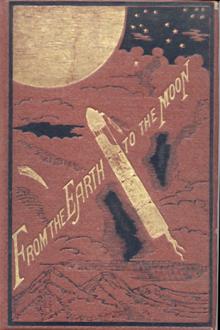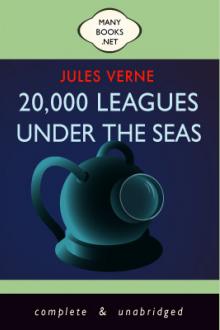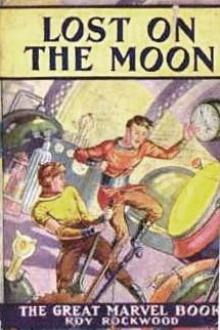From the Earth to the Moon, Jules Verne [online e book reading .TXT] 📗

- Author: Jules Verne
- Performer: -
Book online «From the Earth to the Moon, Jules Verne [online e book reading .TXT] 📗». Author Jules Verne
Was it an illusion, a mistake, an optical illusion? Could they give a scientific assent to an observation so superficially obtained? Dared they pronounce upon the question of its habitability after so slight a glimpse of the invisible disc?
But the lightnings in space subsided by degrees; its accidental brilliancy died away; the asteroids dispersed in different directions and were extinguished in the distance.
The ether returned to its accustomed darkness; the stars, eclipsed for a moment, again twinkled in the firmament, and the disc, so hastily discerned, was again buried in impenetrable night.
THE SOUTHERN HEMISPHERE
The projectile had just escaped a terrible danger, and a very unforseen one. Who would have thought of such an encounter with meteors? These erring bodies might create serious perils for the travelers. They were to them so many sandbanks upon that sea of ether which, less fortunate than sailors, they could not escape. But did these adventurers complain of space? No, not since nature had given them the splendid sight of a cosmical meteor bursting from expansion, since this inimitable firework, which no Ruggieri could imitate, had lit up for some seconds the invisible glory of the moon. In that flash, continents, seas, and forests had become visible to them. Did an atmosphere, then, bring to this unknown face its life-giving atoms? Questions still insoluble, and forever closed against human curiousity!
It was then half-past three in the afternoon. The projectile was following its curvilinear direction round the moon. Had its course again been altered by the meteor? It was to be feared so. But the projectile must describe a curve unalterably determined by the laws of mechanical reasoning. Barbicane was inclined to believe that this curve would be rather a parabola than a hyperbola. But admitting the parabola, the projectile must quickly have passed through the cone of shadow projected into space opposite the sun. This cone, indeed, is very narrow, the angular diameter of the moon being so little when compared with the diameter of the orb of day; and up to this time the projectile had been floating in this deep shadow. Whatever had been its speed (and it could not have been insignificant), its period of occultation continued. That was evident, but perhaps that would not have been the case in a supposedly rigidly parabolical trajectory— a new problem which tormented Barbicane’s brain, imprisoned as he was in a circle of unknowns which he could not unravel.
Neither of the travelers thought of taking an instant’s repose. Each one watched for an unexpected fact, which might throw some new light on their uranographic studies. About five o’clock, Michel Ardan distributed, under the name of dinner, some pieces of bread and cold meat, which were quickly swallowed without either of them abandoning their scuttle, the glass of which was incessantly encrusted by the condensation of vapor.
About forty-five minutes past five in the evening, Nicholl, armed with his glass, sighted toward the southern border of the moon, and in the direction followed by the projectile, some bright points cut upon the dark shield of the sky. They looked like a succession of sharp points lengthened into a tremulous line. They were very bright. Such appeared the terminal line of the moon when in one of her octants.
They could not be mistaken. It was no longer a simple meteor. This luminous ridge had neither color nor motion. Nor was it a volcano in eruption. And Barbicane did not hesitate to pronounce upon it.
“The sun!” he exclaimed.
“What! the sun?” answered Nicholl and Michel Ardan.
“Yes, my friends, it is the radiant orb itself lighting up the summit of the mountains situated on the southern borders of the moon. We are evidently nearing the south pole.”
“After having passed the north pole,” replied Michel. “We have made the circuit of our satellite, then?”
“Yes, my good Michel.”
“Then, no more hyperbolas, no more parabolas, no more open curves to fear?”
“No, but a closed curve.”
“Which is called–-”
“An ellipse. Instead of losing itself in interplanetary space, it is probable that the projectile will describe an elliptical orbit around the moon.”
“Indeed!”
“And that it will become her satellite.”
“Moon of the moon!” cried Michel Ardan.
“Only, I would have you observe, my worthy friend,” replied Barbicane, “that we are none the less lost for that.”
“Yes, in another manner, and much more pleasantly,” answered the careless Frenchman with his most amiable smile.
TYCHO
At six in the evening the projectile passed the south pole at less than forty miles off, a distance equal to that already reached at the north pole. The elliptical curve was being rigidly carried out.
At this moment the travelers once more entered the blessed rays of the sun. They saw once more those stars which move slowly from east to west. The radiant orb was saluted by a triple hurrah. With its light it also sent heat, which soon pierced the metal walls. The glass resumed its accustomed appearance. The layers of ice melted as if by enchantment; and immediately, for economy’s sake, the gas was put out, the air apparatus alone consuming its usual quantity.
“Ah!” said Nicholl, “these rays of heat are good. With what impatience must the Selenites wait the reappearance of the orb of day.”
“Yes,” replied Michel Ardan, “imbibing as it were the brilliant ether, light and heat, all life is contained in them.”
At this moment the bottom of the projectile deviated somewhat from the lunar surface, in order to follow the slightly lengthened elliptical orbit. From this point, had the earth been at the full, Barbicane and his companions could have seen it, but immersed in the sun’s irradiation she was quite invisible. Another spectacle attracted their attention, that of the southern part of the moon, brought by the glasses to within 450 yards. They did not again leave the scuttles, and noted every detail of this fantastical continent.
Mounts Doerful and Leibnitz formed two separate groups very near the south pole. The first group extended from the pole to the eighty-fourth parallel, on the eastern part of the orb; the second occupied the eastern border, extending from the 65@ of latitude to the pole.
On their capriciously formed ridge appeared dazzling sheets, as mentioned by Pere Secchi. With more certainty than the illustrious Roman astronomer, Barbicane was enabled to recognize their nature.
“They are snow,” he exclaimed.
“Snow?” repeated Nicholl.
“Yes, Nicholl, snow; the surface of which is deeply frozen. See how they reflect the luminous rays. Cooled lava would never give out such intense reflection. There must then be water, there must be air on the moon. As little as you please, but the fact can no longer be contested.” No, it could not be. And if ever Barbicane should see the earth again, his notes will bear witness to this great fact in his selenographic observations.
These mountains of Doerful and Leibnitz rose in the midst of plains of a medium extent, which were bounded by an indefinite succession of circles and annular ramparts. These two chains are the only ones met with in this region of circles. Comparatively but slightly marked, they throw up here and there some sharp points, the highest summit of which attains an altitude of 24,600 feet.
But the projectile was high above all this landscape, and the projections disappeared in the intense brilliancy of the disc. And to the eyes of the travelers there reappeared that original aspect of the lunar landscapes, raw in tone, without gradation of colors, and without degrees of shadow, roughly black and white, from the want of diffusion of light.
But the sight of this desolate world did not fail to captivate them by its very strangeness. They were moving over this region as if they had been borne on the breath of some storm, watching heights defile under their feet, piercing the cavities with their eyes, going down into the rifts, climbing the ramparts, sounding these mysterious holes, and leveling all cracks. But no trace of vegetation, no appearance of cities; nothing but stratification, beds of lava, overflowings polished like immense mirrors, reflecting the sun’s rays with overpowering brilliancy. Nothing belonging to a living world— everything to a dead world, where avalanches, rolling from the summits of the mountains, would disperse noiselessly at the bottom of the abyss, retaining the motion, but wanting the sound. In any case it was the image of death, without its being possible even to say that life had ever existed there.
Michel Ardan, however, thought he recognized a heap of ruins, to which he drew Barbicane’s attention. It was about the 80th parallel, in 30@ longitude. This heap of stones, rather regularly placed, represented a vast fortress, overlooking a long rift, which in former days had served as a bed to the rivers of prehistorical times. Not far from that, rose to a height of 17,400 feet the annular mountain of Short, equal to the Asiatic Caucasus. Michel Ardan, with his accustomed ardor, maintained “the evidences” of his fortress. Beneath it he discerned the dismantled ramparts of a town; here the still intact arch of a portico, there two or three columns lying under their base; farther on, a succession of arches which must have supported the conduit of an aqueduct; in another part the sunken pillars of a gigantic bridge, run into the thickest parts of the rift. He distinguished all this, but with so much imagination in his glance, and through glasses so fantastical, that we must mistrust his observation. But who could affirm, who would dare to say, that the amiable fellow did not really see that which his two companions would not see?
Moments were too precious to be sacrificed in idle discussion. The selenite city, whether imaginary or not, had already disappeared afar off. The distance of the projectile from the lunar disc was on the increase, and the details of the soil were being lost in a confused jumble. The reliefs, the circles, the craters, and the plains alone remained, and still showed their boundary lines distinctly. At this moment, to the left, lay extended one of the finest circles of lunar orography, one of the curiosities of this continent. It was Newton, which Barbicane recognized without trouble, by referring to the Mappa Selenographica.
Newton is situated in exactly 77@ south latitude, and 16@ east longitude. It forms an annular crater, the ramparts of which, rising to a height of 21,300 feet, seemed to be impassable.
Barbicane made his companions observe that the height of this mountain above the surrounding plain was far from equaling the depth of its crater. This enormous hole was beyond all measurement, and formed a gloomy abyss, the bottom of which the sun’s rays could never reach. There, according to Humboldt, reigns utter darkness, which the light of the sun and the earth cannot break. Mythologists could well have made it the mouth of hell.
“Newton,” said Barbicane, “is the most perfect type of these annular mountains, of which the earth possesses no sample. They prove that the moon’s formation, by means of cooling, is due to violent causes; for while, under the pressure of internal fires the reliefs rise to considerable height, the depths withdraw far below the lunar level.”
“I do not dispute the fact,” replied Michel Ardan.
Some minutes after passing Newton, the projectile directly overlooked the annular mountains of Moret. It skirted at some distance the summits of Blancanus, and at about half-past seven in the evening reached the circle of Clavius.
This circle, one of the most remarkable of the disc, is situated in 58@ south latitude, and 15@ east longitude. Its height is estimated at 22,950 feet. The travelers, at a distance of twenty-four miles (reduced to four by their glasses) could admire this vast





Comments (0)